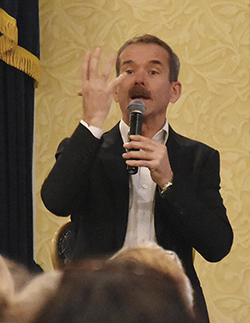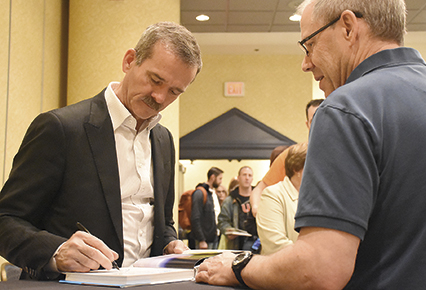Page Content
On the left, a nine-year-old Chris Hadfield pretends a Quaker Oats box is a spaceship. On the right, the space shuttle with Hadfield aboard rockets toward space. Hadfield told teachers: "You guys are in the business of taking people from the left picture to the right picture."
Retired astronaut wows conference crowd
 A group of Alberta math and science teachers got a reminder of the importance of eschewing limitations and the value of failure during a recent address by former astronaut Chris Hadfield.
A group of Alberta math and science teachers got a reminder of the importance of eschewing limitations and the value of failure during a recent address by former astronaut Chris Hadfield.
Hadfield spoke to an assembly of about 600 teachers at a joint conference held by the Alberta Teachers’ Association’s math and science specialist councils. He pointed out that most of the societal norms that we live by, such as how far we sit from others and how loud we talk, we pick up on our own as we grow up.
“Think how many limitations you internalized in your life as a young Canadian without anybody ever actually telling you,” Hadfield said. “One of the most powerful and important things we can do is to let our young see all of the opportunities that actually exist for them and try and find deliberate ways to enable them to do those things.”
Hadfield’s slide presentation showed a photograph of him when he was nine, crammed into a cardboard box, pretending it was a spaceship. Juxtaposed immediately to the right of that photo was a shot of the space shuttle during launch.
Hadfield noted that human space travel didn’t even exist when he was born in 1959 and that his transformation from boy in a box to man in a spaceship happened in 26 years, just half a lifetime.

“You guys are in the business of taking people from the left picture to the right picture,” he said.
The beauty of space flight
Hadfield first visited space during a space shuttle mission in 1995. The odds of dying on that flight were one in 38.
“Bad odds. You’re math teachers; you know that,” he said. “If Air Canada flew with those odds, they would crash nine airliners a day.”
During his hour-long talk, he described in visceral detail the experience of donning an orange flight suit (referred to within NASA as a pumpkin suit) while sitting on the same chair that Neil Armstrong had used, riding 20 storeys up to the space shuttle entrance and crawling on hands and knees into the cockpit of the craft, which he described as “an extremely primitive vehicle” whose rudimentary computer systems relied on just 128 kilobytes of code.
A few minutes before launch, with the astronauts lying on their backs facing straight up, the craft’s hydraulics would begin testing its flight controls, causing the massive engines and rudder to start moving around.
“It’s physically moving underneath you like a beast waking up. It’s both a little unnerving but also really reassuring that this beast is shaking itself and getting ready to go,” Hadfield said.
The shuttle’s huge rockets are like Roman candles the size of apartment buildings, he said, burning 12 tonnes of fuel per second while producing seven million pounds of thrust.
“It is incredibly powerful ... just stunningly powerful to be riding that thing. You feel the raw, brute force of it.”
During liftoff it feels like a gorilla three times your weight is lying on your chest slapping your face, he said. Then, within two minutes, the craft clears the atmosphere and ditches two of its fuel tanks, continuing to accelerate while the ride suddenly goes dead smooth, as if the shuttle hit a patch of freshly resurfaced arena ice.
“It’s a great ride. If you get a chance, I’d really recommend it,” Hadfield joked.
Hadfield was the first Canadian to perform a spacewalk. Viewing the world while not tied to the Earth’s surface delivers with stark clarity the “true preciousness of the planet,” he said.
“To be outside in the universe holding on with one hand ... you are hyper aware of the rareness of the experience and the magnificence of the perspective of the world.”
His experience on the International Space Station included moments of flying through the southern lights, of actually being surrounded by the myriad of colours that make up the magnetospheric phenomenon.
“We would never really see or experience that if we weren’t willing to take an enormous amount of risk and to push ourselves,” he said.
Social media
Hadfield, who was commander of the International Space Station in 2013, gained a worldwide following due to his ongoing efforts to share the experience through social media.
“Astronauts have been so lucky to get to do something on behalf of so many other people and there’s a newness and an inspiration to it that is a really positive effect. I see it as just a fundamental responsibility of all the privilege I’ve had, to [share the experience],” he said in response to a teacher question.
He described social media as a “better way to share the experience of being human” that people are just starting to figure out.
“To me it’s as powerful as the printing press to the democratization of thought,” he said. “It will be interesting to see how it turns out.”
Looking forward
Hadfield also summarized current efforts by entrepreneurs such as Elon Musk (founder of PayPal and Tesla Motors) to pioneer lower-cost space travel so its benefits can be experienced by a broader cross-section of society. So far, testing of the system that Musk is pursuing has resulted in explosive failures, but the team is making great strides with each attempt, which contains a lesson for all, Hadfield said.
|
Teacher reaction
"It’s just amazing what people have done and what we can do in space. I think it’s the next frontier, the next big challenge."
Chris Thomas
Hilltop High School, Whitecourt
"I thought it was very inspirational and I think he’s a great role model for our youth."
Rob McEwen
Hines Creek Composite School
"It was so amazing that I finally meet our astronaut. It’s awesome."
Jimmy Buena
Sister Annata Brockman Catholic School, Edmonton
|
“One of the things you should really stress to your students, if not only stress to yourself, is that everything always breaks and that failure is an important part of success,” he said. “You should actually look forward to it because that’s where you learn the most. Early success is a terrible teacher.”
Hadfield also shared a message of personal responsibility, encouraging audience members to look inward rather than blaming politicians or others for the world’s ills.
“We need to actually take personal responsibility for changing things, and that starts with letting young people see that this is actually something they have control over. They can be that agent of change,” he said.
Toward that end, he advocates the same approach he took to becoming an astronaut: building a great platform of personal competence and then applying it to the problems that exist.
“You folks are absolutely intrinsic in having that process happen.” ❚
